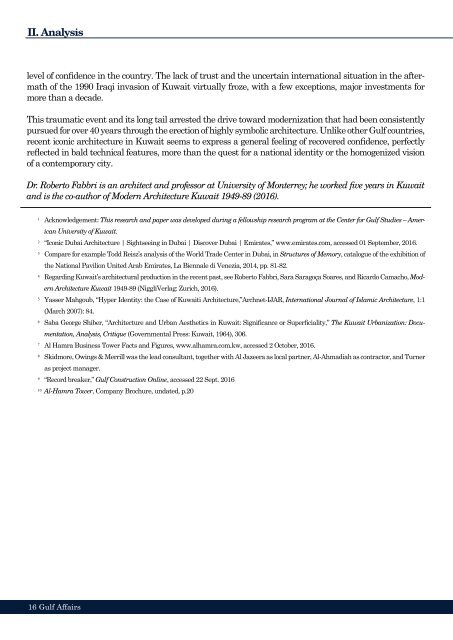You also want an ePaper? Increase the reach of your titles
YUMPU automatically turns print PDFs into web optimized ePapers that Google loves.
II. Analysis<br />
level of confidence in the country. The lack of trust and the uncertain international situation in the aftermath<br />
of the 1990 Iraqi invasion of Kuwait virtually froze, with a few exceptions, major investments for<br />
more than a decade.<br />
This traumatic event and its long tail arrested the drive toward modernization that had been consistently<br />
pursued for over 40 years through the erection of highly symbolic architecture. Unlike other Gulf countries,<br />
recent iconic architecture in Kuwait seems to express a general feeling of recovered confidence, perfectly<br />
reflected in bald technical features, more than the quest for a national identity or the homogenized vision<br />
of a contemporary city.<br />
Dr. Roberto Fabbri is an architect and professor at University of Monterrey; he worked five years in Kuwait<br />
and is the co-author of Modern Architecture Kuwait 1949-89 (2016).<br />
1<br />
2<br />
3<br />
4<br />
5<br />
6<br />
7<br />
8<br />
9<br />
10<br />
Acknowledgement: This research and paper was developed during a fellowship research program at the Center for Gulf Studies – American<br />
University of Kuwait.<br />
“Iconic Dubai Architecture | Sightseeing in Dubai | Discover Dubai | Emirates,” www.emirates.com, accessed 01 September, 2016.<br />
Compare for example Todd Reisz’s analysis of the World Trade Center in Dubai, in Structures of Memory, catalogue of the exhibition of<br />
the National Pavilion United Arab Emirates, La Biennale di Venezia, 2014, pp. 81-82.<br />
Regarding Kuwait’s architectural production in the recent past, see Roberto Fabbri, Sara Saragoça Soares, and Ricardo Camacho, Modern<br />
Architecture Kuwait 1949-89 (NiggliVerlag: Zurich, 2016).<br />
Yasser Mahgoub, “Hyper <strong>Identity</strong>: the Case of Kuwaiti Architecture,”Archnet-IJAR, International Journal of Islamic Architecture, 1:1<br />
(March 2007): 84.<br />
Saba George Shiber, “Architecture and Urban Aesthetics in Kuwait: Significance or Superficiality,” The Kuwait Urbanization: Documentation,<br />
Analysis, Critique (Governmental Press: Kuwait, 1964), 306.<br />
Al Hamra Business Tower Facts and Figures, www.alhamra.com.kw, accessed 2 October, 2016.<br />
Skidmore, Owings & Merrill was the lead consultant, together with Al Jazeera as local partner, Al-Ahmadiah as contractor, and Turner<br />
as project manager.<br />
“Record breaker,” Gulf Construction Online, accessed 22 Sept. 2016<br />
Al-Hamra Tower, Company Brochure, undated, p.20<br />
16 Gulf Affairs


